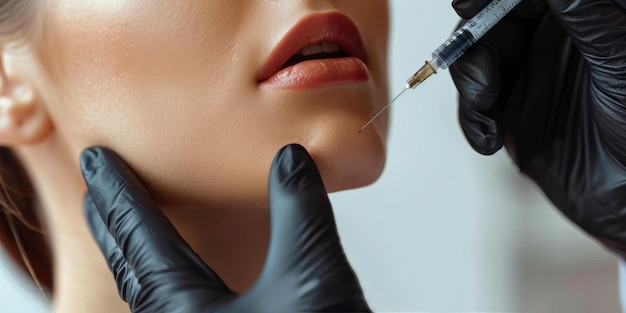The field of aesthetic medicine has witnessed remarkable advancements over the past few years, especially in non-surgical cosmetic procedures. Among these innovations, jawline fillers have emerged as a popular choice for individuals seeking to enhance their facial structure. These fillers offer a versatile and effective solution for achieving a more defined jawline, balancing facial features, and enhancing overall aesthetics. As technology continues to evolve, the options and techniques surrounding Jawline Filler Injections in Dubai are becoming increasingly sophisticated.
The Evolution of Jawline Fillers
Historically, dermal fillers were primarily used to treat facial volume loss and wrinkles, with little emphasis on specific facial contouring. However, the growing demand for aesthetic procedures has driven researchers and practitioners to refine the formulation and application of jawline fillers. Today, various types of fillers, including hyaluronic acid (HA) and calcium hydroxylapatite, are available, each offering unique benefits for jawline enhancement. This evolution has paved the way for more tailored and effective treatments, ensuring that patients achieve the desired results with minimal downtime.
Advanced Formulations and Techniques
Recent innovations in jawline filler technology focus on improving the formulation of fillers to provide longer-lasting results and a more natural appearance. New-generation fillers are designed to integrate seamlessly with the skin, allowing for smooth and even results. For instance, some fillers now feature enhanced viscosity and elasticity, enabling practitioners to sculpt the jawline more precisely.
Moreover, new techniques such as microcannula insertion and dynamic imaging have been introduced to enhance safety and efficacy. Microcannulas, which are thin, flexible tubes, reduce trauma to the tissue during the injection process, minimizing swelling and bruising. This advancement allows for more strategic placement of fillers, resulting in improved contours without compromising natural movement.
Personalized Treatment Approaches
One of the most significant trends in jawline filler technology is the move toward personalized treatment plans. Practitioners now assess each patient's unique facial anatomy, skin type, and aesthetic goals before recommending a specific type of filler or technique. This tailored approach ensures that the treatment not only enhances the jawline but also harmonizes with the overall facial proportions.
Additionally, advanced imaging technology is being utilized to simulate potential outcomes, helping patients visualize the results before undergoing treatment. This not only boosts patient confidence but also empowers them to make informed decisions regarding their aesthetic goals.
The Role of Hybrid Fillers
Hybrid fillers are a recent innovation that combines the benefits of various filler types to achieve optimal results. These fillers often blend hyaluronic acid with other substances, such as poly-L-lactic acid or calcium hydroxylapatite, to enhance longevity and improve skin quality. Hybrid fillers provide a more comprehensive solution for jawline contouring, as they not only fill but also stimulate collagen production over time.
As a result, patients experience both immediate enhancement and progressive improvement in skin texture and elasticity. This dual benefit sets hybrid fillers apart from traditional options, making them an appealing choice for individuals looking to achieve a long-lasting jawline contour.
Safety and Regulatory Advancements
With the rise in popularity of jawline fillers, regulatory bodies are taking steps to ensure the safety and efficacy of these products. Innovations in manufacturing processes and stringent quality control measures have been implemented to guarantee that fillers meet the highest standards. Additionally, new clinical guidelines are being established to promote best practices in injection techniques and patient care.
Practitioners are also increasingly educated on the importance of understanding facial anatomy, recognizing potential complications, and employing advanced techniques to minimize risks. This focus on safety ensures that patients can enjoy the benefits of jawline fillers with greater peace of mind.
Combining Treatments for Enhanced Results
Another notable trend in jawline filler technology is the practice of combining treatments to achieve more comprehensive results. For instance, many practitioners are now pairing jawline fillers with other non-surgical procedures, such as neurotoxins (e.g., Botox) and skin rejuvenation treatments, to enhance overall facial aesthetics.
By addressing multiple concerns simultaneously, practitioners can create a more balanced and harmonious appearance. This combination approach not only improves the jawline's definition but also enhances the overall facial contour and texture.
Non-Surgical Alternatives to Traditional Surgery
As demand for non-surgical aesthetic procedures grows, jawline fillers present a viable alternative to traditional surgical options. Many individuals seek non-invasive solutions due to the benefits of minimal downtime, reduced risks, and immediate results. Innovations in jawline filler technology have further solidified their place as a popular choice among patients who desire subtle yet impactful changes without the need for surgery.
Advancements in filler materials and injection techniques enable practitioners to create natural-looking results that complement each patient's unique features. This non-surgical route allows individuals to achieve their desired jawline without undergoing lengthy recovery times associated with surgical procedures.
Future Directions in Jawline Filler Technology
As the field of aesthetic medicine continues to evolve, the future of jawline filler technology holds exciting possibilities. Ongoing research is focused on developing even more advanced formulations that provide longer-lasting results while maintaining a natural appearance. Additionally, innovations in delivery methods and injection techniques are likely to enhance precision and patient comfort.
Furthermore, there is a growing emphasis on sustainability within the aesthetic industry. Future advancements may include the development of eco-friendly fillers and packaging materials, reflecting the industry's commitment to environmental responsibility.
Conclusion
In summary, innovations in jawline filler technology have transformed the landscape of non-surgical aesthetic procedures. With advanced formulations, personalized treatment approaches, and a focus on safety, patients now have access to options that meet their unique needs and preferences. As technology continues to advance, the potential for jawline fillers to enhance facial aesthetics is greater than ever, making it an exciting time for both practitioners and patients alike. The journey toward achieving the ideal jawline has never been more accessible, safe, and effective.






Comments